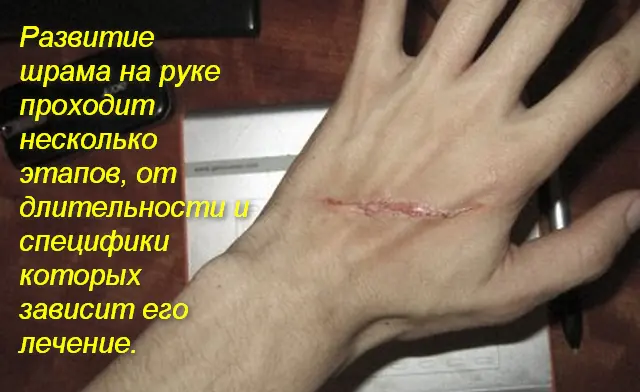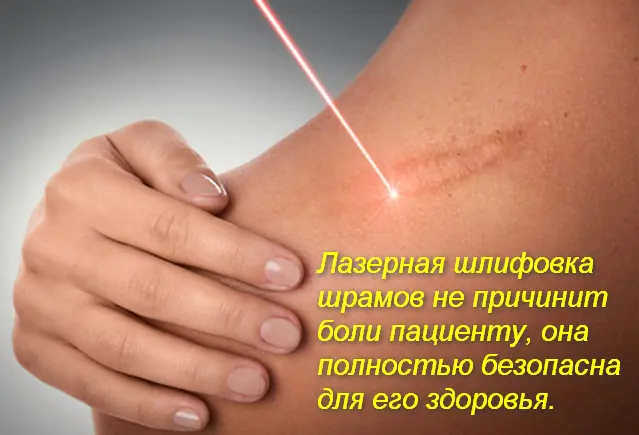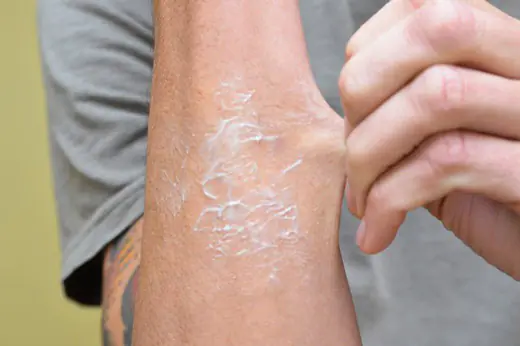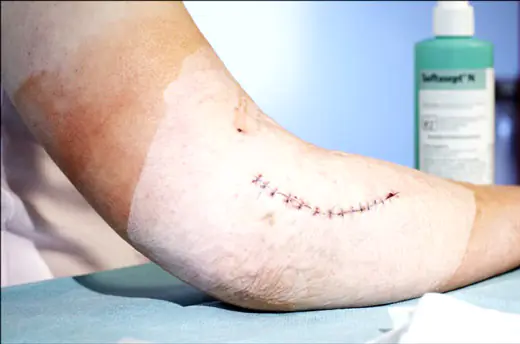After severe injuries and abdominal surgeries, deep scars remain on the body, which sometimes, for no apparent reason, change color from white to red, after which they begin to grow rapidly. This process is usually accompanied by quite unpleasant sensations and even pain, which cannot but cause concern. What is the reason for such changes in scar tissue? Are they dangerous? You will find answers to these and many other questions in this article.
The content of the article:
Why a hypertrophied scar may appear
Scars of a red or pink hue that protrude above the surface of the body are called hypertrophied or hypertrophic. They form slowly - over the course of six to eight months. During this period, the scar may itch, turn red, and “grow” beyond the edges of the wound - in principle, there is nothing wrong with this: these changes indicate active regeneration of previously damaged tissues. You should be wary only if the scar has become painful and liquid has begun to ooze from it - ichor or pus. In such a situation, you should consult a doctor.
If no pain or suspicious discharge is observed, the scar should be left alone. Of course, it is difficult to distance yourself from what is happening when health is at stake: is there a person in the world who is indifferent to what exactly is happening to his body at this particular moment? Still, there is no need to worry: both the growth and redness of the scar are natural.
The scar grows due to increased production of collagen, a substance designed to “hold together” torn or cut muscle fibers, and turns red due to the formation of new blood vessels, which will partially resolve as the tissue is restored.
Causes of hypertrophied scars and redness of the skin on the scar
For some, scars left after surgery or resulting from a serious injury turn red and increase in size, while for others they dissolve without a trace. Doctors explain this feature by a genetic predisposition to tissue scarring. It has been proven that in people whose relatives suffered from scar hypertrophy, the wounds scar in a similar way.
Along with heredity, the location and origin of the wound, accompanying complications, and the qualifications of the specialist involved in the treatment of injuries can affect the size, shape and color of the scar. Thus, during many years of observations, the following interesting patterns were revealed:
1 A scar from a third or fourth degree burn shows signs of hypertrophy in ninety-nine percent of cases out of a hundred, while minor burns usually heal without a trace.
2 Wounds located on moving parts of the body (in the area of joints, in the neck) are prone to hypertrophic scarring due to the structural characteristics of the tissues located in these areas.
3 Infection and suppuration of tiny wounds can provoke the formation of giant hypertrophied scars, which even a laser machine cannot smooth out.
4 A hypertrophic scar after mole removal may be the result of unskilled medical intervention. A professional should remove nevi with a laser, a radio knife, a scalpel, or liquid nitrogen. If a doctor or cosmetologist has little experience in this area, the patient is guaranteed scar hypertrophy.
5 Red scars on the face or décolleté can be found in people who prefer to remove acne and other skin imperfections mechanically. When they squeeze out an inflamed pimple or boil, the dermis in the designated area is damaged, which leads to the formation of an unsightly scar, which hypertrophies over time.
Redness and growth of the scar as a reason to consult a doctor
Hypertrophied scars are easily confused with colloidal scars, which can cause a lot of trouble to their owner. The following reminder will help you distinguish one type of education from another:
1 If the scar turns red and extends beyond the wound, it is too early to panic: if less than eight months have passed since the injury or operation, the tissues have not yet had time to properly grow together, so the scar changes. But if the scar begins to grow rapidly six months after the injury or medical intervention, and even its sensitivity has sharply increased, you should see a doctor.
2 If the scar changes color, begins to respond with pain to pressure and hampers movement, you should immediately go to the hospital - a colloidal scar has begun to form at the site of the wound.
To avoid the formation of keloid scars, it is necessary to notify the attending physician about the presence of a genetic predisposition to scar hypertrophy at the examination stage. In this case, the specialist will prescribe appropriate treatment that will prevent unwanted complications.
Also, in order to minimize the risk, it is recommended to abandon invasive techniques in favor of gentle methods of examination and treatment (if circumstances permit, it is better to resort to laser therapy or endoscopy rather than surgery).
Another point worth considering for those who are predisposed to scar hypertrophy concerns plastic surgery and cosmetic procedures. People at risk are not recommended to resort to invasive intervention: even such a seemingly simple procedure as the injection of fillers or Botox can lead to the formation of unaesthetic red scars in their case.
How to get rid of hypertrophied scars
If your scars are bothersome, you can try the following to help them heal faster:
1 Medications in the form of creams, ointments, patches based on substances that slow down collagen production.
2 Surgical intervention.
3 Cosmetic procedures aimed at smoothing the skin texture (resurfacing or acid peeling).
The use of traditional medicine gives a good effect:
1 Compress from fresh cucumber (the fruit is peeled, crushed into pulp and spread in a thick layer over the scar).
2 Lemon juice (squeezed citrus juice is moistened with a cotton pad, which is then used to carefully treat the scar - wipe the scar three to four times a day).
The substances contained in cucumber and lemon inhibit collagen production, lighten tissue, and also disinfect the skin. If you regularly resort to their help, the scar will fade and become less pronounced.
Scars remaining on the body after deep cuts cause serious aesthetic discomfort to their owners, especially if these rough “marks” are located on open areas of the body. The longer such scars remain on the skin, the more difficult it is to get rid of them: over time, the injured skin tissue becomes very rough.
From our article you will learn how to remove scars from cuts on your hand using traditional and folk medicine, as well as what medications are best to use in this situation.

Specifics of the appearance of scars
Scars are damage to the skin as a result of mechanical impact from piercing or cutting objects. Most often, scars appear on the hands while performing daily duties.
If the upper skin layer is damaged, traces of the cut are minimal, as it has quick recovery properties. If the cut is deep, affecting the deep layers of the skin, or the wound is infected, the formation of a scar will be inevitable.
The size and depth of the scar directly depends on how quickly and correctly assistance was provided for deep cuts. Such injuries must be treated with antiseptics, then a pressure bandage is applied, having previously connected the edges of the wound. If the wound is very deep, you need to seek help from a medical facility: the doctor will put stitches on it.
The development of a defect on the hand in the form of a scar goes through several stages, the duration and specificity of which determine its treatment.

You can begin the process of scar removal only at the final stage. In this case, the treatment method must be determined by a specialist who will rely on the characteristics of the occurrence of the injury and its depth.
The choice of methods for getting rid of scars depends on their types, the features of which are presented in the table.

Regardless of the treatment prescribed by a specialist, you can use traditional methods of scar removal. Such a complex effect will help get rid of unsightly “marks” much faster.
Hardware methods for scar removal
If cut scars remain on the skin for a long time, removing them without medical intervention will be difficult, and sometimes impossible. Let's look at the most popular techniques that can be used to eliminate scars.
Chemical peeling
The most popular remedy for getting rid of scars. Peeling effectively combats the growth of scars, aligning healthy and damaged tissue. The essence of the procedure is the use of light acids (for example, phenol). They are able to penetrate into the deepest layers of the skin, evening out their texture.
The disadvantages of chemical peeling include the following features of the technique:
- The procedure is carried out only in autumn or winter, since exposure to ultraviolet radiation will have an extremely negative effect on the condition of the skin;
- To completely remove scars you will need at least 7 sessions.
These shortcomings are compensated by the complete removal of scars, as well as a big bonus: the skin on the hands becomes smooth and silky.

Laser resurfacing
During the procedure, scars are exposed to infrared rays, which “excise” layers of injured tissue. Grinding will not cause pain to the patient; it is completely safe for his health.
The downside of the procedure is that the renewed skin hurts for several days, taking on a red, unhealthy appearance. In addition, to exclude possible infection, after it you need to use a local drug with an antibacterial effect. But after a week, the skin of your hands will not only remain without unsightly scars, but will also look younger, acquiring a healthy and well-groomed appearance.
Microdermabrasion
This is the name of a type of peeling that eliminates shallow scars on the surface of the skin.
Damaged skin is polished with a special apparatus containing a diamond tip. It is with its help that the upper keratinized areas of the dermis are removed. The gentle action of the product allows the skin to quickly regenerate, so there will be no need for recovery time after the procedure.
Sessions are painless, and their number depends on the degree of skin damage.
Plastic surgery
Plastic surgery will help get rid of postoperative stitches. With its help, the oldest scars are removed. True, you should not rush to choose this method, since only a good specialist can perform high-quality plastic surgery.
Plastic surgery is performed using one of 3 methods:
- Giving the scar a different contour;
- Skin grafting;
- Excision of the scar followed by a small suture inside the skin.
Lipofilling and mesotherapy
Such techniques are used when scars are located below the level of the skin. Their specificity is the introduction of hyaluronic acid or collagen under the scars.
Separately, we should dwell on the scars that remain after cutting the veins. It is impossible to completely eliminate them, because the use of the above methods after such cuts is prohibited.
The only way out in this situation is to make the scar less noticeable using cream or ointment, which must be thoroughly rubbed into the skin during a massage.
"Home" methods
A deep cut of a finger, the consequences of which appear in scars, can be cured without resorting to hardware techniques. Most often, “home” methods are used when there are certain contraindications to medical procedures. They are also effective for minor skin damage.
The only disadvantage of home treatment is its duration: to make the scar slightly noticeable or completely get rid of it, it will take from 6 to 12 months.
For treatment, you can use effective ointments that have a healing and absorbable effect. These include the following:
To enhance the effect of the ointment against scars, after applying it, use a special “slimming” patch.

Here are a few traditional medicine recipes that can be used to eliminate an unpleasant formation on the skin.
Make a mask containing oatmeal, 3-4 drops of lemon juice and cream. The resulting mask is placed on the scar and kept there for 15 minutes, then the hands are washed with warm water.
Homemade ointment based on badger fat.
You will need the following plants:
All herbs are taken in equal proportions, then the resulting mass is poured with vodka. The tincture is placed in a dark place and infused for 13-14 days. At the final stage of preparing the cream, badger fat, melted in a water bath, is mixed with settled herbs.
Use the ointment once a day, in the evening before going to bed, carefully rubbing the scar with it.
Vegetable oil and beeswax are mixed in proportions of 4 to 1. The mixture is boiled over low heat for 8-10 minutes. The finished ointment is poured into a glass container and allowed to cool. The lotion is kept on the scar for half an hour, 2 times a day. The course of treatment cannot be interrupted after 3 weeks.
The scar can be eliminated using a calendula-based compress. To prepare it, you need to pour 2 large spoons of flowers with boiling water (half a liter will be enough). Carefully wrap the container with the infusion for 2 hours. After it has cooled, strain and use as a lotion 2 times a day. The procedure is carried out for at least 20 minutes.
Among the simplest, but very effective folk remedies, honey and lemon juice should be highlighted. These products should not be mixed with anything; they should be applied to the scars daily, thoroughly rubbing into the skin.
Scars are an extremely unpleasant and unsightly phenomenon. The easiest way to get rid of them is immediately after the wound has healed. Therefore, you should not delay visiting a specialist who will help you choose the best treatment method for you.
After abrasions and various mechanical damage, scars appear that cannot always be hidden. Their depth and size depend on following the treatment rules. But if the defect is still noticeable and causes discomfort, let’s consider how to remove scars from cuts on the hand.
Features of appearance
Scars on the hand are the result of mechanical damage to the human skin. These can be cuts from a knife, blade or cutting object. Small scratches leave no marks. And the deep ones probably won’t be able to be hidden from the eyes of others.
The top layer of the epidermis is called the basal layer. He has a high level of regeneration ability. If you only cut it, the likelihood of scarring will be minimal. At most, a barely noticeable scar of natural flesh color can form.
If the edges of the wound are smooth, there is a chance that the resulting scar can be hidden or disguised with foundation. This is possible if the cut was fixed in time with a bandage or sutures in the correct position relative to the edges. Then the likelihood of deep scars being formed is reduced.
Infection is a common cause of scarring, since when infected, an inflammatory process occurs in the damaged areas.
The appearance of scars is preceded by injuries, cuts or inflammatory processes on the skin.
Human skin is not able to recover completely from damage. In these areas, instead of the usual skin, connective tissue appears, which forms scars.

Stages of scar formation:
- The initial stage, which lasts about 1 week. During this period, the active phase of the inflammatory process occurs, characterized by tissue swelling.
- The second stage is the formation of a young scar. The skin is delicate and can be easily re-injured. Parents should monitor even their children's cuts to ensure they heal properly.
- Mature stage. During this period, the scar enters a phase characterized by a change in skin color from bright red to pale pink.
- The final stage. It occurs after 4 months from the date of injury. Only upon completion of maturation, the doctor assesses the state of scarring and determines methods on how to get rid of scars on the hands.
Types of scars
Any person wants to feel successful and beautiful, and girls try to maintain attractiveness. Medicine can significantly influence the condition of damaged skin areas and make the scar less noticeable. Before choosing a treatment method, it is necessary to determine the type of scar.
Kinds:
- Keloid. This type appears on the skin as a result of burns. You can remove it using an operation.
- Atrophic. Scars form in the deep layers of the dermis. More often they appear after a person has had chickenpox, with a rash in places where there were acne, insect bites, or with multiple wounds.
- Hypertrophic. Appears on the surface of the skin and is red in color. It is advisable to remove it after consulting a doctor. Scars form after serious mechanical injuries; they are also typical for drug addicts, as you can see in the photo on the Internet.
- Stretch marks. Occur after pregnancy or with sudden weight loss, especially on the right and left thighs. You can get rid of them with peeling, laser correction, homemade scrubs and wraps.
- Surgical scars. Such scars can be removed with a laser by polishing the damaged areas of the skin.
How to get rid
Hiding scars on your hand from cuts in the summer is quite difficult. To do this, women cover them with cosmetics, cover their wrists with various accessories, or cover them with clothes. But masking will not help you forget about your injuries and hide psychological problems associated with aesthetic discomfort.

Several methods can be used to make a scar less noticeable or remove it. These include:
- Chemical peeling. The procedure helps hide old cut scars on the arms, shoulders or other parts of the body. Depending on the number of procedures, scars disappear or become hidden.
- Laser resurfacing. It is performed more often for women after the birth of a child. Stretch marks and other defects of tight skin will be removed by an experienced doctor after several sessions.
- Surgical intervention. The specialist removes excess skin, smoothes or transplants new tissue in place of the scar.
- Ethnoscience. This includes homemade tinctures and ointments based on celandine, aloe juice and chamomile. Traditional methods help cover up and hide scars, but they cannot be completely removed.
You can disguise scars and scars on your hand from cuts using cosmetics - foundation or durable camouflage cosmetics. This method will be effective in the presence of light-colored scars.
Preparations and ointments
Chemical peeling or laser resurfacing are effective methods of combating scars after vaccinations and other abrasions. But there are other means by which, even at home, you can hide a scar. This includes:
- creams “Kelofibraza”, “Clirvin”;
- ointments “Sledotsit”, “Kontratubeks”, “Scarguard”;
- gels “Dermatix”, “Rescuer”;
- homemade and cosmetic skin scrubs.
The effectiveness of scar removal using ointment or cream depends on the size of the damage, the degree of elevation above the skin, and the period of limitation. Young defects can be easily corrected, but old scars are much more difficult to hide.
Rules for healing injuries on the hands
Scars do not cause physical pain to a person, including the scar on the left arm from vaccination. They create psychological discomfort. For proper removal, you should consult a doctor.
Rules for proper wound healing:
- treat the injury with antiseptic agents to prevent infection;
- seek help from a doctor to fix the correct position of the wound edges;
- reduce the level of physical activity during the wound healing period;
- use healing creams and ointments;
- do not peel off the top layer;
- monitor the condition of the cut;
- Do not use vinegar or acidic liquids;
- show the condition of the wound to the doctor.
Is it possible to disguise a tattoo scar?
During the medical examination, doctors pay attention to the places where the tattoos were removed. People burn and cut out tattoos, trying to get rid of hated designs on their bodies. Doctors advise carrying out the removal procedure with the help of experienced surgeons and qualified cosmetologists.



